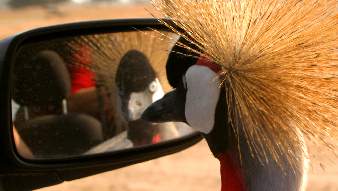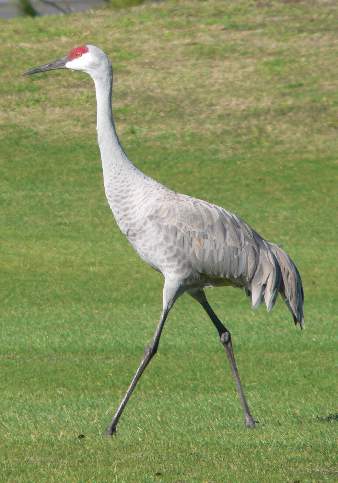
How do I look today? Picture of Grey Crowned Crane checking himself out in a car wing mirror.

Picture of Sandhill Crane.
|
The Crane is the Old German,
Kraen.
Both the English and Old German names are a pictorial rewriting of
the loud and harsh trumpeting tone, which is typical for the European Crane.
In French the crane is known as Grue, in Spanish
Grulla and
in Greek Gearanos.
Cranes are the Gruidae family
of birds, which is part of the order Gruiformes. There are about
15 species of crane.
They are large, tall and
mainly terrestrial birds (generally from 85 to 175 cm). With
a long neck and long legs, they have a graceful stature, with a mainly
grey or white plumage, some having chestnut tones.
They are somewhat similar in appearance to herons but differ by the Crane's
larger size and shorter bill. Some Crane species, for example the
Grey Crowned Crane (Balearica regulorum) which is picured on this page have an ornamental feather
crest in the area where the head meets the back of the neck.
Crane Habitat
Representatives of the Crane
family are found on all continents of the earth except in the Antarctic
and South America. Cranes were once far more common than today
but their population numbers are reducing throughout
the world, much of the reason being because the areas of peaceful
and calm habitat which they need to live in are declining. The greatest
diversity of Crane species are found in Asia, with relatively large numbers
also being found in Africa.
They are birds who
like grassy wetlands and wide, open areas of water, for example shallow
lakes and marshland or wide, slow-moving rivers. They move in elegant strides
with their long legs and gather seeds and insects with their long bills.
They are gregarious birds who live in flocks
and communicate between themselves using noisy
vocalizations. Many of them, are migratory
birds, who travel long distances. Their
flight is a graceful sight to see, with their neck extended and their wide
wings slowly but powerfully propelling them.
Cranes are opportunistic
feeders. They change their diet depending on seasonal conditions.
Thus they eat fish, small rodents, and amphibians, but change
over to grains and berries during the late summer and autumn.
Crane Courtship Display and
Nest
They have a spectacularly complex
and loud courtship display. The males and the females stretch their
necks and open their wings, both bobbing and jumping up and down whilst
calling to each other. Cranes have a very long windpipe and emit acute
trumpeting sounds which can be heard two kilometers away.
Objects like twigs are sometimes grabbed by the beak and thrown high into
the air.
Once they have chosen a partner they will stay
together for life in a monogamous, pairing. The
Crane's nest is constructed of mud and vegetation in the marshy regions
where it inhabits. A relatively dry spot is usually selected where
the herbage is not particularly high. Generally two eggs are laid,
which are then incubated for around 30 days. The chicks hatch with
downy feathers and can soon follow the parents. The young birds receive
the care and attention of both the mother and father Crane.
|





